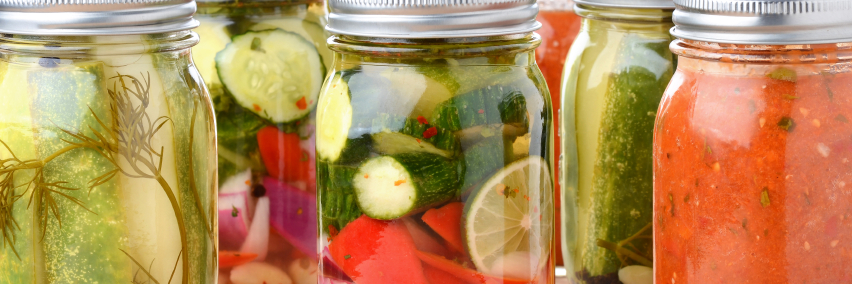Nick Dow's blog : Several myths about twists: the benefits and harms of home preservation

Myth 1: Vegetables and fruits lose their beneficial properties during
conservation.
There is an opinion that during preservation vegetables and fruits lose
their beneficial properties - this is certainly true, there are fewer
vitamins. However, the body still receives benefits.
For example, during heat treatment, many vitamins and microelements are
actually destroyed, for example, vitamin C. At the same time, heated lycopene
and beta-carotene are much easier for the body to absorb. For example,
lycopene is found abundantly in tomatoes and red-tinged vegetables and fruits
and is known for breaking down fats and having antioxidant properties.
In turn, beta-carotene helps the body to maintain the integrity of
cells, generally fights aging, strengthens the immune system and also has
antioxidant properties.
At the same time, some trace elements are simply not destroyed even
during heat treatment - for example, calcium and magnesium. It turns out
that our body will still receive a dose of nutrients and microelements.
Myth 2: Preservation can be added to the diet for gastritis and ulcers.
In this case, no matter how much you would like to taste a pickled
cucumber or tomato, it is still better to abstain. The fact is that
preservation has a negative effect on the stomach, and sometimes it can even
aggravate the disease. Doctors in particular do not recommend the use of
preservation for gastritis and high acidity.
Myth 3: Low-quality products are used for store preservation
It is worth remembering that when using low-quality vegetables and
fruits, the recipe simply does not work - the method of processing the fruits
does not allow using spoiled ones.
Myth 4: Do not use iodized salt and sea salt for preservation
The myth that you should not use iodized salt for preservation appeared
several decades ago and has been confusing housewives ever since. The fact
is, earlier in the process of enriching salt with iodine, potassium iodite was
used, which could negatively affect the quality of homemade pickles and
conservation. However, in the modern process of iodization, potassium
iodate is used, which in no way spoils home spins.
At the same time, doctors emphasize that the purity of the salt is
important for conservation; various impurities can spoil not only the look, but
also the taste of pickles.
Chefs and nutritionists agreed that sea salt, which contains about 40
micro and macro elements, is the best option not only for cooking, but also for
canning. In addition, it is much more useful than usual, and accordingly,
conservation will become more useful.
Myth 5: Conservation impairs appetite
Scientists and nutritionists have long come to the conclusion that
conservation not only contains beneficial microorganisms, but also speeds up
metabolism. True, doctors still advise to refrain from using preservation
in the evenings - the salt content can lead to puffiness in the morning.
Myth 6: Preservation is a relatively new way to preserve food.
During the excavation of the tombs of Tutankhamun, archaeologists
discovered clay molds sealed with a special resin. As it turned out,
various vegetables and fruits were placed in them, and then they were poured
with olive oil, which made it possible to pickle and preserve the products for
longer. So, preservation is by no means a new way to preserve food.
By the way
Little
tricks:
To prevent cans from exploding, add a pinch of mustard seeds to the
brine.
A few thin slices of horseradish root, placed under the lid, will
protect the cucumbers from mold. will also protect from an explosion 1
tbsp of alcohol or vodka.
A piece of oak bark will make the cucumbers crisp.
To make the cucumbers saline faster, cut their tails or prick them with
a fork.
Little
tricks:
Rinse the tomatoes thoroughly in warm water before canning.
Sort the tomatoes - don't mix tomatoes of different varieties and
ripeness in the same jar. Before canning, sort the tomatoes and divide
them into ripe, green, and brown, and sort them by size - large, small and
medium.
Small and medium-sized tomatoes are best suited for
preservation. Do not use very large tomatoes - they are suitable for
making juice for pouring.
Keep the fruit free from spots, defects, cracks and stalks.
Give preference to fruits of medium ripeness, which will not burst in
the future. So that they do not crack, they can be pricked at the location
of the stalk with a wooden needle.
Tomatoes can be canned with or without skin. In any case, they must first be steam-blanched for 2 minutes and then cooled. After this treatment, the skin is easily removed. And if you are not going to remove it, it will simply kill all the germs.
One of the most popular products bought in stores is sausage. It is used as an appetizer during festive feasts, sandwiches, salads, and even soups (okroshka, hodgepodge) are made with it. But, of course, no purchased one can compare to the taste of a homemade canned sausage. It has its own special and unique taste due to the fact that it is prepared from natural ingredients, without the use of chemical additives and only fresh high-quality products are used in the process. Therefore, any housewife should try to cook it on her own at least once. In practice, this is not as difficult as it might seem. Moreover, such a sausage can be stored in the refrigerator for a long time or it can even be frozen and taken out as needed. Or you can do it differently and just roll it up in jars. It will be much easier and if you unexpectedly come to visit, then you just need to open the jar and fresh homemade sausage will be on your table. How much pleasure your family and guests will get from such a natural and high quality product!
To make the result always pleasing, then when preparing this simple, but such a rare snack, use the following secrets:
It is better to choose fatter meat. Then the sausage will be more juicy and tender.
Cool the meat before cooking. To do this, it will be enough to put it in the refrigerator overnight. This will give a better grind.
Minced meat must be kneaded well to remove excess air and get a dense, good texture in the finished product, without voids.
Before cooking, the intestines should be soaked in cool salted water for two hours. After that, they should be rinsed in lukewarm water inside and out and at the same time check their integrity.
If voids are formed during the filling of the intestine with minced meat, then you can pierce the finished product in several places with a toothpick so that it does not burst during the cooking process.
It is better to fry the finished sausage in animal fat (pork, beef), so the crust will turn out much tastier.
Of course, it is important to be able to choose the right pork, because the taste of the whole product will depend on its quality:
Fresh pork is light pink with white fat.
It is imperative to press on the pulp with your finger, if the hole quickly takes its original shape, then it means that it is fresh and can be bought.
Too much liquid indicates that the meat has been frozen.
In:- Social media


